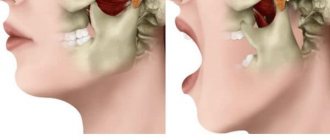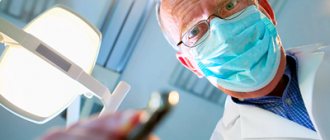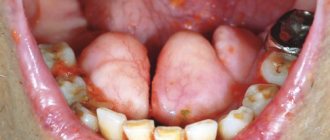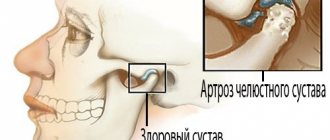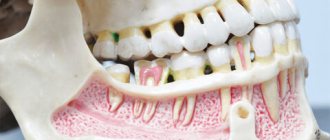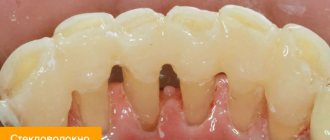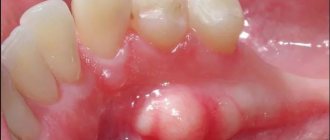Structure
The formation of the mandibular region is the result of the evolution of the human body. In the process of development, the entire structure became mobile and autonomous, gaining the ability to move freely and perform the basic functions necessary for a person. The temporal joint is localized in the fossa, connecting to the bony part.
When a subluxation occurs, the head of the joint partially comes out of the fossa, succumbing to the influence of external factors. As a rule, this phenomenon becomes a consequence of a general weakening of the ligaments or disturbances in the articular cavity. If you have the proper skills and practical experience, you can restore the original position of the jaw yourself, but the systematic occurrence of such a problem is the basis for complex treatment.
Dislocation of the lower jaw
First aid consists of reversing the dislocation of the lower jaw under infiltration or conduction anesthesia. To reduce the anterior dislocation of the lower jaw, the methods of Hippocrates, Khodorovich, Blechman, Gershuni, Popescu (for old dislocations) are used. The classic way to reduce bilateral dislocation of the lower jaw is the Hippocratic method: the patient sits on a low chair, so that the back of the head is supported, and the lower jaw is located at the level of the elbow joints of the dentist or traumatologist/surgeon. Standing opposite the patient's face, the doctor places his thumbs, wrapped in a towel or a thick layer of gauze, on the lower molars, and with the rest covers the lower jaw from the outside. Gently pressing down with his thumbs, the doctor moves the jaw back with a small push, quickly removing his fingers from the teeth to avoid biting. The movement of the articular heads of the lower jaw into place is accompanied by a characteristic click and intense closure of the jaws.
When reducing a posterior dislocation after the lower jaw has been displaced downward, it is moved anteriorly. In order to avoid recurrent dislocation of the lower jaw and limit movement in the TMJ after the reduction procedure, it is necessary to immobilize the jaw using a chin sling for 7-10 days (for anterior dislocation) and for 2-3 weeks (for posterior dislocation). Until recovery, the patient is advised to stop eating solid food and follow a gentle diet. If it is impossible to reduce the dislocation of the lower jaw using conservative methods, they resort to the surgical method. For chronic dislocations of the lower jaw, resection of the articular heads of the lower jaw may be required, followed by mechanotherapy.
Patients often learn to adjust habitual dislocations of the lower jaw on their own. Further treatment should include therapy for the underlying disease, wearing it for 2-3 months. medical orthopedic devices and splints that limit mobility in the joint (Petrosov apparatus, Burgonskaya-Khodorovich apparatus, Yadrova splint). According to indications, it is necessary to carry out selective grinding of teeth, prosthetics of missing teeth, blockade of masticatory muscles, massage, therapeutic exercises, physiotherapy (electrophoresis of medicinal substances, galvanization).
Surgical treatment of habitual dislocation of the lower jaw can be aimed at strengthening the ligaments, deepening the articular cavity, increasing the height of the articular tubercle, repositioning and fixing the intra-articular disc.
Causes and classification
Displacement of the lower jaw is the result of the application of an external force that exceeds in intensity the force of natural fixation. For each person, such a threshold is individual - some patients may suffer from minor force, while others are able to endure strong mechanical impact without consequences.
The main factors determining the tightness of the fit are ligament tension and bone attraction. The weakening of these connections can provoke the occurrence of subluxation, both one-time and in a chronic form. The reasons that negatively affect the condition of the jaw region include:
- Advanced stages of rheumatism;
- Developing arthritis or osteomyelitis;
- The occurrence of cramps and muscle spasms;
- Consequences of encephalitis;
- Epileptic seizures.
They also note the existence of traumatic factors, the occurrence of which can cause subluxation:
- Mechanical injuries - impacts, collisions;
- Excessive opening of the mouth;
- Having bad habits;
- Congenital abnormalities that affect the formation of the articular fossa.
The classification used in dentistry differentiates pathology according to the following criteria:
- Based on the position of the articular head - anterior, posterior and lateral subluxation;
- According to the specificity of the displacement - one-sided and two-sided form;
- Depending on the severity - for simple and complex cases.
The choice of technique, as well as the timing of treatment, depend on the original source of the problem. It is easiest to cure the pathology in the early stages, so at the first symptoms of subluxation it is recommended to consult a doctor and undergo an examination.
Reduction of dislocation of the lower jaw
Few people know that you can get a dislocation of the lower jaw by simply yawning, when the mouth opens too wide. It can also be triggered by mechanical impact, sudden movement, a history of certain diseases, and incorrect treatment by a dentist. The most common pathology of mismatched articular surfaces of the jaws is in women. According to age parameters, adults and elderly people are more susceptible to dislocation of the mandibular joint. A dislocation of the mandibular joint is said to occur when the head of the mandible protrudes from the glenoid cavity of the temporal bone.
How to tell if your lower jaw is dislocated
Some people walk for years with a dislocated lower jaw, unaware of the pathological condition of the joint. It is difficult for a specialist not to notice the anomaly, so when a patient goes to the dentist, it is determined by the doctor immediately.
In general, dislocation of the jaw joint is characterized by:
- difficulty opening and closing the mouth;
- position of the lower jaw, as a result of which the face loses its previous shape. The lower jaw appears to be protruding or skewed to one side;
- speaking becomes more difficult, diction suffers;
- strong salivation appears;
- acute pain occurs.
In medical practice, it is customary to distinguish unilateral dislocation, in which the pathology affects one joint without receiving a mirror image on the other side. In such a combination of circumstances, a person has a slightly open mouth and a chin that deviates to the side. Bilateral dislocation also occurs, when both heads of the joint pop out. At the same time, the jaw moves forward, the mouth opens completely, saliva is released intensely, great difficulties arise when swallowing, and diction suffers greatly.
If the ends of the bones in the joints partially touch, then they speak of incomplete dislocation or subluxation. If contact is completely lost, then the dislocation is called complete. A simple dislocation of the jaw is not accompanied by a loss of integrity of the skin on the face, but when tendons are torn, the integrity of blood vessels, skin and soft tissues is compromised, it is customary to speak of a complicated dislocation. There is also an anterior dislocation of the jaw, when the head, emerging from the cavity, moves forward. And the back one, when it is facing backwards.
Reduction of dislocation of the lower jaw
Since the dislocation becomes visible already upon visual examination, it is possible to make initial assumptions about the pathology, confirming them by palpation. The diagnosis must be completed with an x-ray to rule out more serious injuries. To correct the situation, you should push the jaw back into place using slow and steady movements so that the chewing muscles can enter a relaxed state. The main steps must be followed:
- The doctor sits the patient facing him on a hard chair so that the back of his head rests on a solid support, and his jaw is located at the level of the elbow bends of the specialist standing in front of him.
- The doctor wraps the thumbs with a cloth (bandage, scarf, gauze, towel) and places them on the chewing molars of the lower jaw, covering the jaw from the outside with his hands.
- By pressing on the lower jaw, the doctor carefully moves the joint, directing it to the desired position.
Ideally, the procedure should be carried out in an emergency room, but with an uncomplicated dislocation, a dentist can also help by carefully straightening the patient’s jaw if the need arises.
For severe pain impulses, local anesthesia is used. After the procedure, a tight fixing bandage is applied to the jaw to ensure immobility of the joint. The patient walks with it for up to 2 weeks. At this time, the consumption of hard, viscous and sticky foods is excluded, preference is given to soups and soft pureed foods. our specialists or make an appointment right now by phone: 8 (347) 299-64-64. Call.
Symptoms and signs
For each form of subluxation, there are characteristic individual signs that indicate the presence of deviations. However, there are a number of universal symptoms observed in all types of pathology:
- The occurrence of pain of varying severity, aggravated when the patient attempts to move the lower jaw;
- Limited mobility of the temporomandibular joint, making it difficult to perform usual actions - eating or speaking;
- Active secretion of saliva associated with a swallowing problem.
In addition, with bilateral dislocations affecting the anterior zone, the following circumstances occur:
- Inability to close the jaws, forcing the patient to keep his mouth open;
- Pain in the skull and swelling of tissue in the ear area;
- Partial or complete dysfunction of the speech apparatus.
The unilateral form of subluxation has similar symptoms, but allows partial closure of the mouth, which significantly alleviates the patient’s problems. In turn, posterior bilateral subluxation is characterized by the opposite symptomatology - the inability to open the jaw, pressing of the lower part into the larynx area.
First aid and treatment
If a subluxation occurs, it is recommended to straighten the jaw using the infiltrative or guide method, after first calming the patient and giving him an anesthetic. The lack of such skills requires contacting a qualified orthodontist, who will not only restore the natural structure of the jaw apparatus, but also advise measures aimed at restoring and preventing recurrences. If the procedure aimed at realigning the joint is carried out in a timely manner, as well as medical recommendations are followed during the rehabilitation period, the prognosis for a complete cure is very favorable.
Symptoms of a dislocated jaw
Jaw displacement is difficult to miss. The dislocation can be anterior bilateral, unilateral or posterior. The following symptoms will help identify injury:
- the mouth is “frozen” in an open or closed position;
- pain in the parotid area when trying to close or open your lips;
- difficult to talk;
- facial symmetry is broken;
- increased salivation;
- with a posterior dislocation – it is difficult to swallow and breathe;
- with unilateral dislocation, the symmetry of the face is disrupted.
In the above cases, the dislocation is called acute. There is also a chronic (“habitual”) dislocation of the jaw, which develops as a result of accidents, inflammation of the ligaments, dental problems and other diseases (for example, arthritis, rheumatism, in which the joints are deformed).
